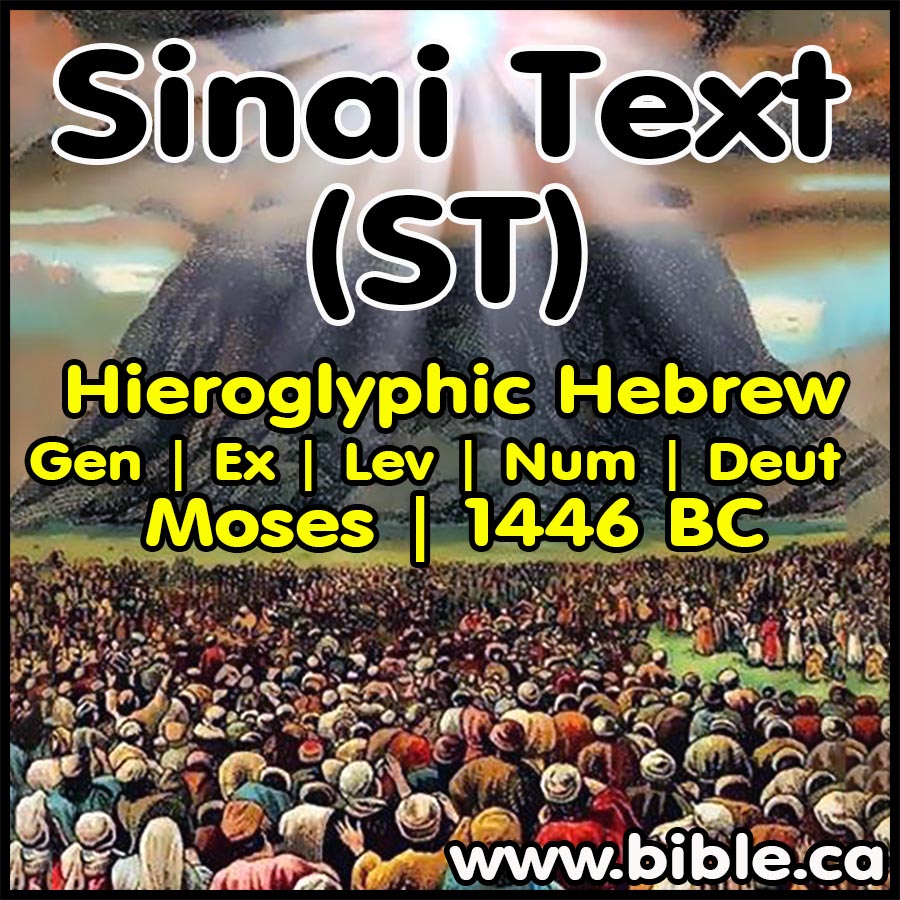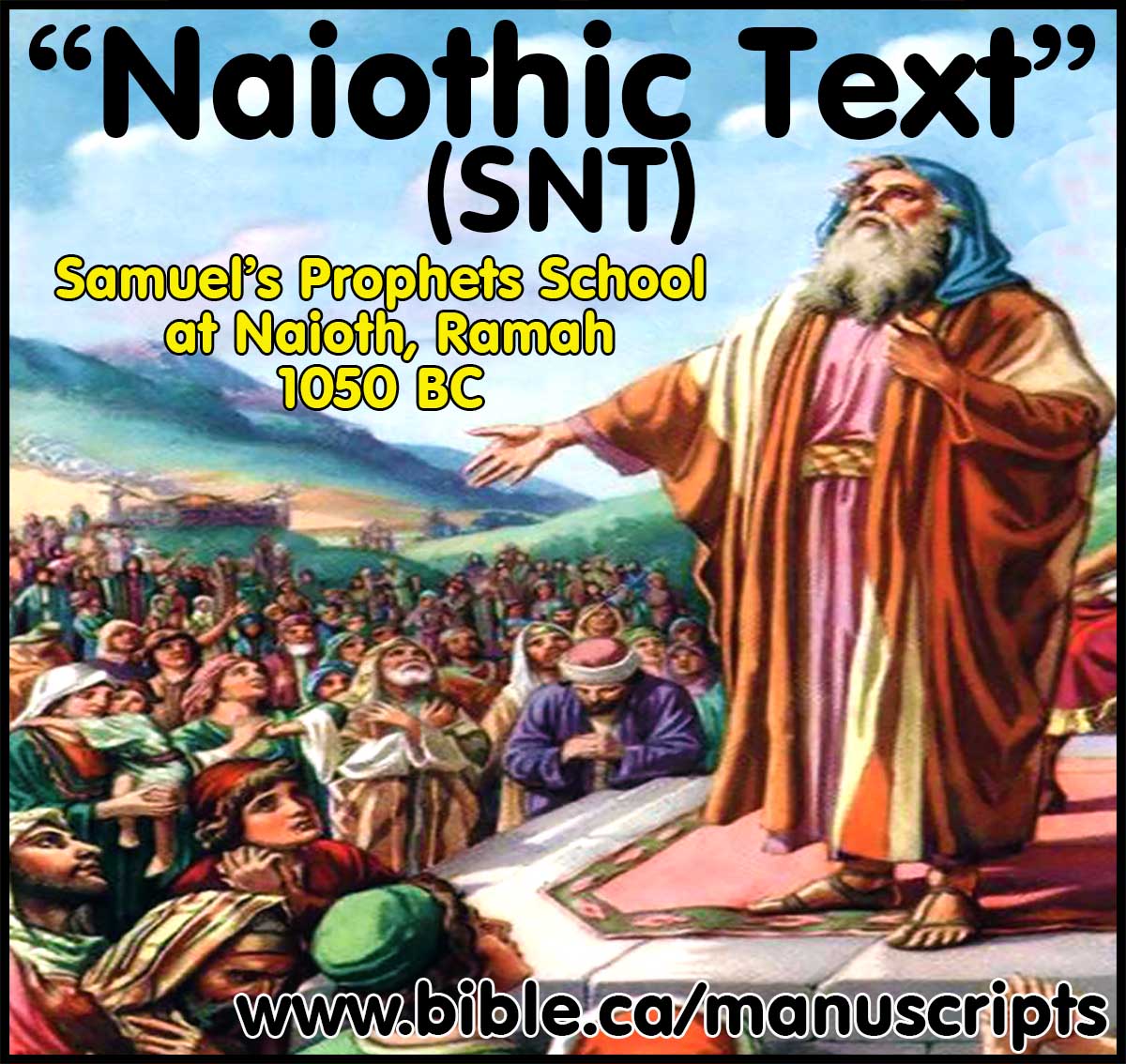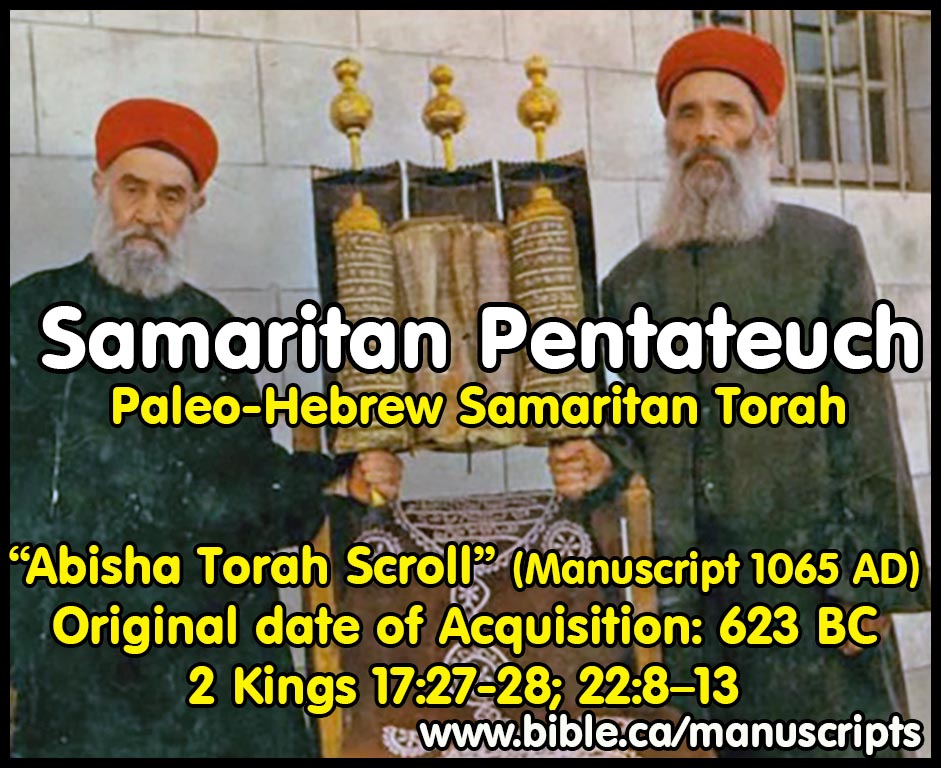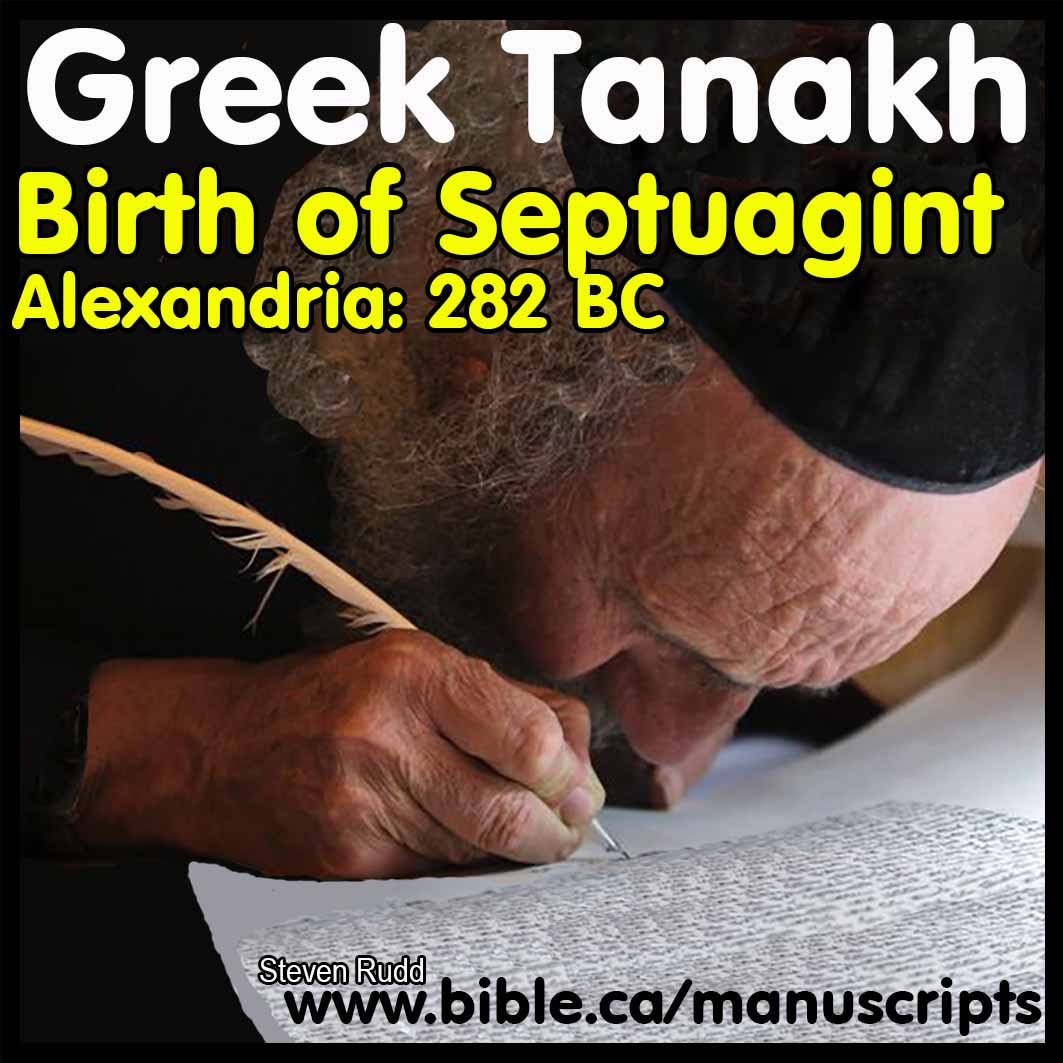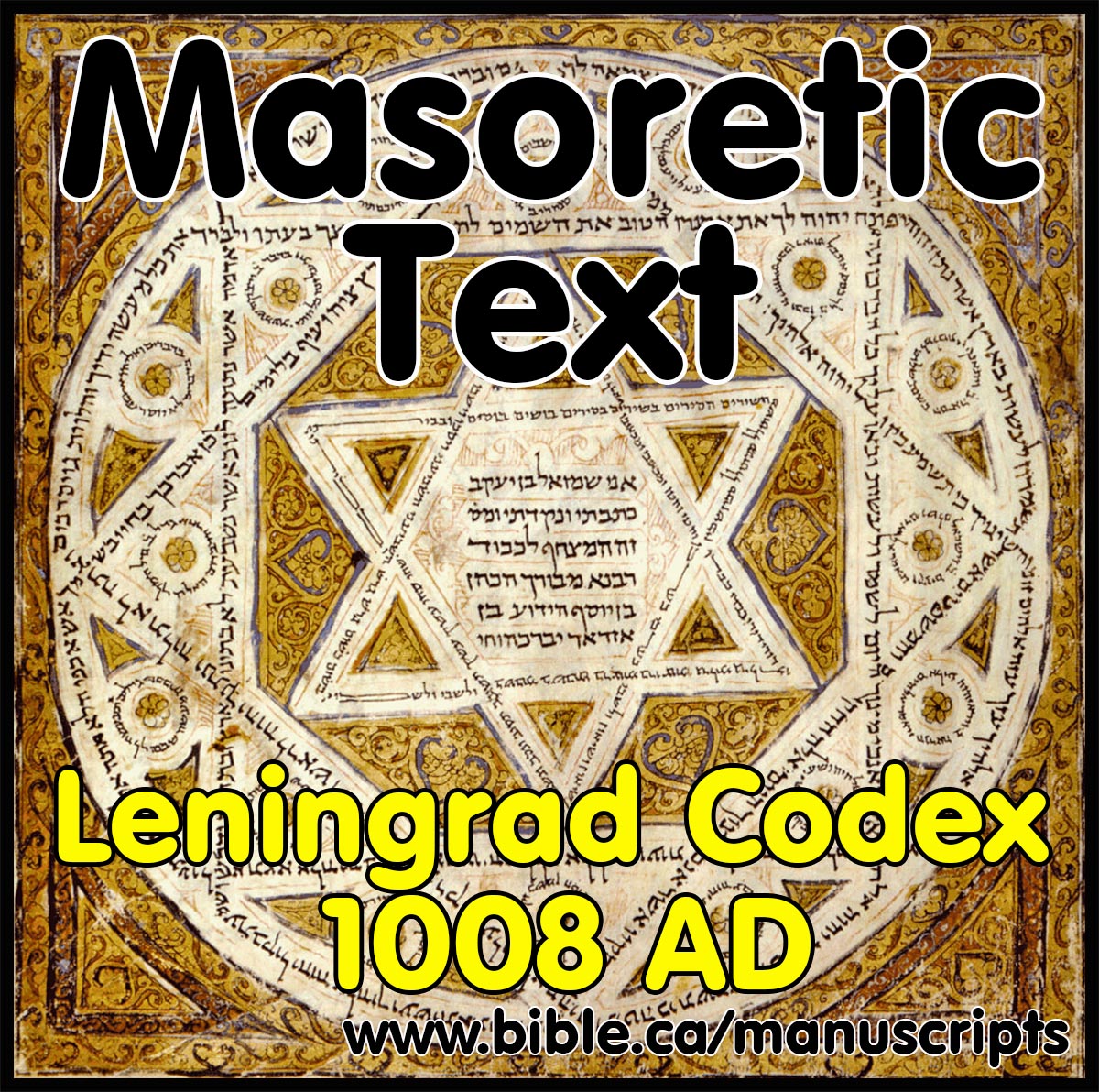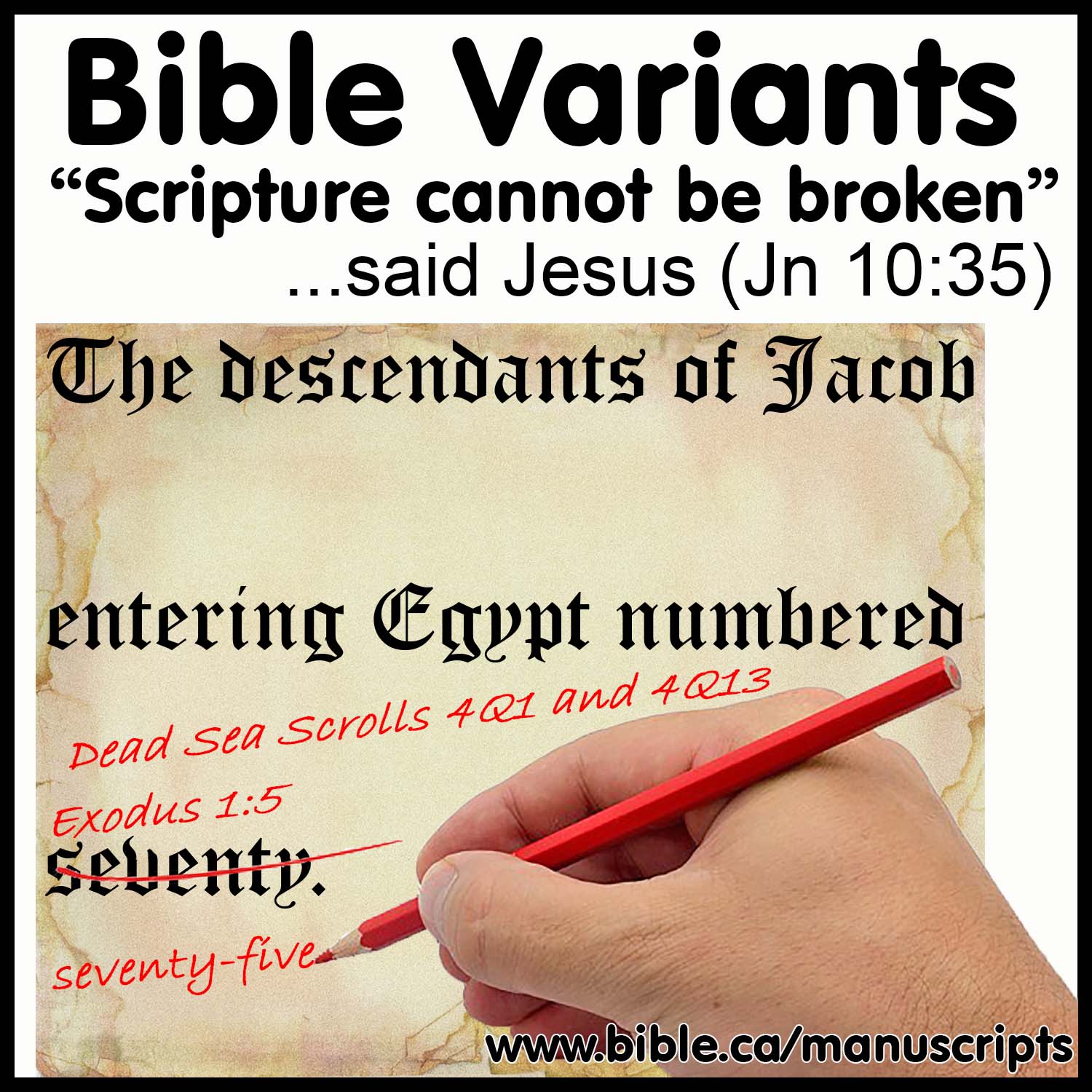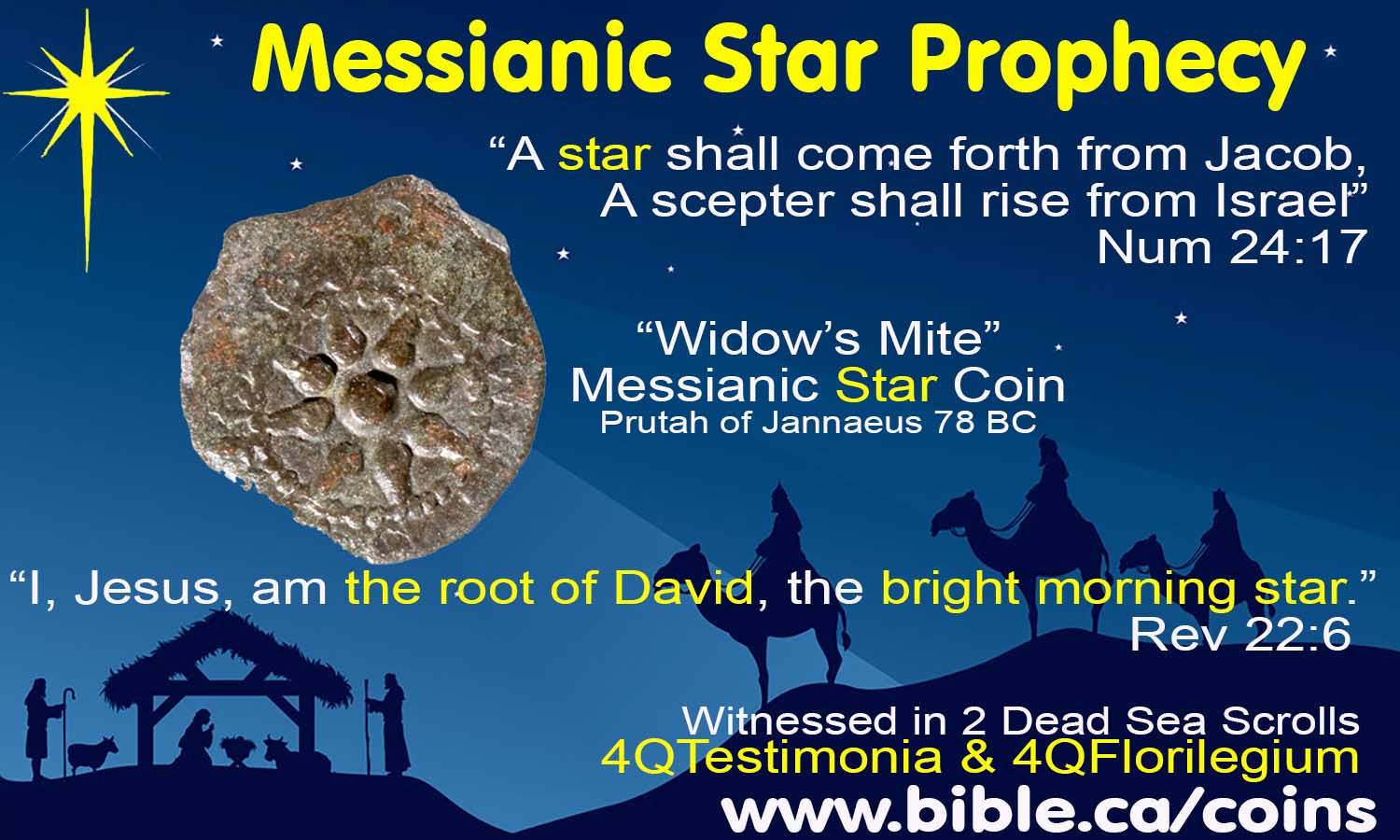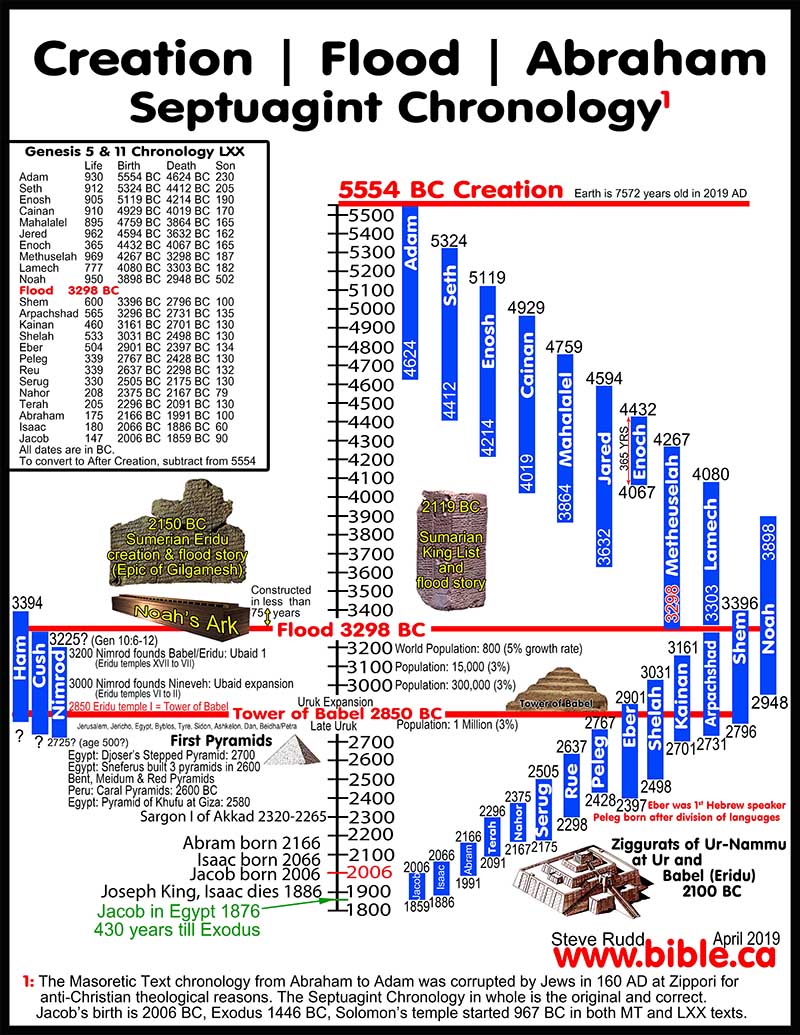|
Shem CANNOT BE Melchizedek using the Septuagint chronology Shem was Melchizedek using the Masoretic chronology A test case for validating or falsifying the Septuagint Genesis 11 chronology as original "Scripture cannot be broken" (Jesus, John 10:35) "My word will accomplish what I desire and succeed in the purpose for which I sent it." (Isa 55:11) Steve Rudd November 2017
|
Shem as Melchizedek: A test case for validating or falsifying the Septuagint Genesis 11 chronology as original
|
Primeval Chronology of Genesis 11 |
|||||||
|
|
Septuagint (LXX) (Correct original) |
Masoretic (MT) (Corrupted in 150 AD) |
Samaritan (SP) (Corrupted) |
||||
|
Man |
Year at Birth |
Rem./Life9 |
Year at Birth |
Rem./Life9 |
Year at Birth |
Rem. Years |
Life9 |
|
Shem1 |
100 |
500/600 |
100 |
500/600 |
100 |
500 |
600 |
|
Arphaxad |
135 |
430/565 |
35 |
403/438 |
135 |
303 |
438 |
|
Cainan |
130 |
330/460 |
Skipped |
- |
skipped |
- |
- |
|
Shelah |
130 |
330/460 |
30 |
403/433 |
130 |
303 |
433 |
|
Eber |
134 |
370/504 |
34 |
430/464 |
134 |
270 |
404 |
|
Peleg |
130 |
209/339 |
30 |
209/239 |
130 |
109 |
239 |
|
Reu |
132 |
207/339 |
32 |
207/239 |
132 |
107 |
239 |
|
Serug |
130 |
200/330 |
30 |
200/230 |
130 |
100 |
230 |
|
Nahor |
79 |
129/208 |
29 |
119/148 |
79 |
69 |
149 |
|
Terah2 |
130 |
75/205 |
130 |
75/205 |
708 (130) |
75 (158) |
145 |
|
Gen 11 Yrs3 |
1230 years |
450 years |
1100 years |
||||
|
Gen 5 Yrs |
2158 years |
1558 years |
1209 years |
||||
|
Abram born |
2166 BC |
2166 BC |
2166 BC |
||||
|
Creation4 |
5554 BC |
4174 BC5 |
4475 BC |
||||
|
Flood6 |
3298 BC |
2518 BC7 |
3168 BC |
||||
|
Steve Rudd 2017 AD |
|||||||
Footnotes:
1 Shem begat Arphaxad at age 100 which was two years after the flood.
2 Christians know from Acts 7:4 that Abraham was born when Terah was 130 years old not 70. This is an interpretive variance, not a textual one in spite of the fact that Jews from 300 BC to the present wrongly maintain that Terah was 70 when Abraham was born.
3 Total years from birth of Arphaxad to birth of Abraham in 2166 BC.
4 Creation date is derived by adding the begetting columns in both charts to the date Abraham was born in 2166 BC.
5 The Jews from 300 BC down to the present day wrongly set the age of Terah at the birth of Abraham at 70 which calculates an age of the earth at 4114 BC. The truth is that Terah was 130 years old, which calculates age of the earth according to the MT at 4114 BC + 60 = 4174 BC.
6 Flood date is calculated by subtracting [total Gen 5 years] from [creation date] and adding [98 years] because Shem was born in Noah’s 502nd year and the flood occurred when Noah was 600 years old.
7 Because Jews have wrongly believed from 150 BC to the present that Terah was 70 years old when Abraham was born instead of the correct begetting age of 130 you must add 60 years to the MT flood date of 2458 BC to arrive at the actual MT flood date of 2518 BC.
8 While the numbers in the MT show that Terah was 130 when Abraham was born and that Abraham left Haran at age 75 after Terah died at age 205, the Jews incorrectly interpreted the birth of Abraham when Terah was 70. What this meant in their interpretation, was that Tarah continued to live in Haran for another 60 years after Abraham left for Canaan. This was always problematic until the Christian Bible explicitly stated that Abraham did not leave Haran until after the death of Terah at age 205 (see Acts 7:4). The Samaritans fudged the numbers for the life span of Terah from 205 down to 145 in order to have Terah die before Abraham left Haran. So in the Samaritan corrupted chronology they incorrectly have Abraham born when Terah was 70 and Terah dying at age 145 when Abraham leaves for Canaan at age 75. But today we are certain that Terah was 130 years old when Abraham was born which creates a huge problem for the Samaritan Pentateuch because this means Terah dies when Abraham is only 15 years old and now Abraham continues to live in Haran for another 60 years after Terah dies before he leaves for Canaan. This is clear proof of a corrupt and fabricated Samaritan chronology because the prevailing FALSE view of Jews as far back as 150 BC to the present, is that Terah was 70 when Abraham was begotten. Had the Samaritans just left the text alone, they never would have been caught red handed with irrefutable proof (Abraham was not 15 years old when Terah died), that they deliberately corrupted the Samaritan Pentateuch chronology in Gen 5,11.
9 Life numbers (total years lived) are not in the text of either the LXX or MT. However they are added in the SP. For example, in Gen 11:11 the Samaritan Pentateuch adds the words: “All the days of Shehm [Shem] were 600 years and he died”. The SP adds the total life years lived for each person in the Gen 11 chronology. This is a corruption of the original text.
Introduction:
1. Shem as Melchizedek is a test case for validating or falsifying the Septuagint Genesis 11 chronology as original:
a. If we can find literary sources before 160 AD that say Shem was Melchizedek this falsifies the theory that the Jews corrupted the Masoretic text in 160 AD by reducing the age of the earth in the Gen 5 and 11 chronologies. In this case, we would suspect that the longer Septuagint numbers were changed and the shorter Masoretic numbers are original.
b. If we find no literary sources before 160 AD that say Shem was Melchizedek this validates the theory that the Jews corrupted the Masoretic text in 160 AD by reducing the age of the earth in the Gen 5 and 11 chronologies.
2. THE GREAT JEWISH FLIP-FLOP IN THEOLOGY:
a. In 100 BC, the Jews universally viewed Melchizedek as a “messianic angelic being” and when Jesus Christ came, it was a perfect fulfillment with their messianic expectation.
b.
In 160 AD, Shem became Melchizedek who transferred his priesthood
to Abraham, Isaac and Jacob. The Jews wanted to disconnect Jesus Christ from
being a priest after the order of Melchizedek (book of Hebrews) so they
corrupted the text in their Hebrew pre-Masoretic Torah to counter Christian
theology.

i. In 160 AD, Seder Olam Rabbah was the nasty fraudulent and corrupt chronological document the Jews created for this purpose.
ii. In order for Shem to be the same person as Melchizedek, Shem must be alive at the time of Abraham.
iii. The original and authentic Septuagint chronology in Gen 11 makes it impossible for Shem to be Melchizedek because he dies hundreds of years before Abraham is born.
iv. At the time of Christ, the chronological numbers in Gen 5 and 11 in both the Septuagint and the Hebrew pre-Masoretic text were almost identical.
v. The Jews in 160-180 AD modified the chronological numbers in their Hebrew pre-Masoretic text by reducing the age of the earth and compressing the genealogy between Shem and Abraham.
vi. The other change they made was making Shem firstborn and “the great” over his brother Japheth: Shem was second-born and NOT Melchizedek. Japheth “the Great” was firstborn in the LXX. They couldn’t suddenly redefine Shem as Melchizedek if his older brother Japheth was called “the great” in both the Greek Septuagint and the Hebrew pre-Masoretic text (MT)
3. As you can see, the chronological numbers Gen 11 for the time span between Shem and Abraham in the Septuagint (LXX), Masoretic (MT) and Samaritan Pentateuch (SP) are all different.
|
Gen 11 Years from Shem to Abraham |
||
|
Septuagint (LXX) (Correct original) |
Masoretic (MT) (Corrupted in 160 AD) |
Samaritan (SP) (Corrupted) |
|
1230 years |
450 years |
1100 years |
a. Notice that the Jews compressed the genealogy in Gen 11 but the Samaritans did not!
b. The Samaritans also corrupted their genealogies in Gen 11, but for different reasons.
c. The Samaritans do not believe Shem is Melchizedek and the Genesis 11 chronology in Paleo-Hebrew Torah proves it.
d. “Melchizedek … he is Shem the Great.” The identification with Shem is facilitated by the biblical chronology of Gen 11:10–26 (Hebrew text), which gives 290 years from the birth of Shem’s first son to the birth of Abram and says Shem lived five hundred years after the birth of his first son. In Nf and Pal. Tg., Shem was also in contact with Isaac (Nf Gen 24:62) and Rebekah (Nf Gen 25:22). The identification is also in rabbinic sources; see Grossfeld, op. cit., Gen 14 note 26. Jerome (Hebr. quaest. in Gen 14:18–19, CCL 72, 29) tells us that the Hebrews say that Melchizedek was Shem the Great, and reckoning his lifespan they show that he lived to Isaac’s time, and they say that all the firstborn of Noah, until Aaron, exercised the priesthood and were priests. The identification of Melchizedek and Shem was also known to Ephrem. On the same views in Jerome, see Hayward, art. cit., in note to 14:2 above.” (The Aramaic Bible, The Targum Neofiti Translated with a Critical Introduction Apparatus and Notes, K. Cathcart, M. Maher, Martin McNamara, Volume 1A to Genesis, p 92, footnote 22 at Gen 14:18, 1992 AD)
4. Shem as Melchizedek:
a. The Genesis 11 chronology of the LXX and SP make it impossible for Shem to be Melchizedek because he dies hundreds of years before Abraham is born.
b. The Genesis 11 chronology of the MT has Shem living to the time of Jacob! In fact, the MT has every descendent of Noah in the chronology living down to the birth of Abraham! This of course, is absurd and proof of a deliberate corruption by the Jews in 160 AD at Zippori.
c. SHEM LIVED TO SEE ISAAC: "And Rebekah and her maiden rose up and mounted on camels and went after the man. And the servant took Rebekah and went. And Isaac was coming from the sanctuary of Shem the Great, to the well over which was revealed the One who sustains every age. And he was dwelling in the land of the South. And Isaac had gone out to pray in the open field at evening time; and he raised his eyes and saw and behold, camels were coming. And Rebekah raised her eyes and saw Isaac and she let herself down from the camel. And she said to the servant: “Who is that man who is coming in the open field toward us?” And the servant said: “It is my master.” And she took her veil and covered herself with it. And the servant told Isaac everything that he had done. And Isaac brought her into the tent of Sarah his mother; and he took Rebekah and she became his wife; and he loved her and Isaac was consoled after Sarah his mother had died." (The Aramaic Bible, The Targum Neofiti Translated with a Critical Introduction Apparatus and Notes, K. Cathcart, M. Maher, Martin McNamara, Volume 1A to Genesis, p 127, Translation of Genesis 24:61–67, 1992 AD)
d.
SHEM LIVED TO SEE JACOB AND ESAU: "And Isaac
was forty years when he took as wife Rebekah, the daughter of Bethuel the
Aramaean from Paddan, the sister of Laban the Aramaean. And Isaac prayed before
the Lord concerning Rebekah his wife because she was barren; and the Lord
answered him and Rebekah his wife conceived. And the children pushed one
another in her womb and she said: “If such is the tribulation of children, why,
now, do I have children?” And she went to the school of
Shem the Great to beseech mercy from before the Lord. And the Lord said to her:
“Two peoples are in your womb, and two kingdoms from your womb will be
separated; and one kingdom will be stronger than the other kingdom, and the
greater will serve before the smaller.” (The
Aramaic Bible, The Targum Neofiti Translated with a Critical Introduction
Apparatus and Notes, K. Cathcart, M. Maher, Martin
McNamara, Volume 1A to Genesis, p 129, Translation of Genesis
25:20–23, 1992 AD)
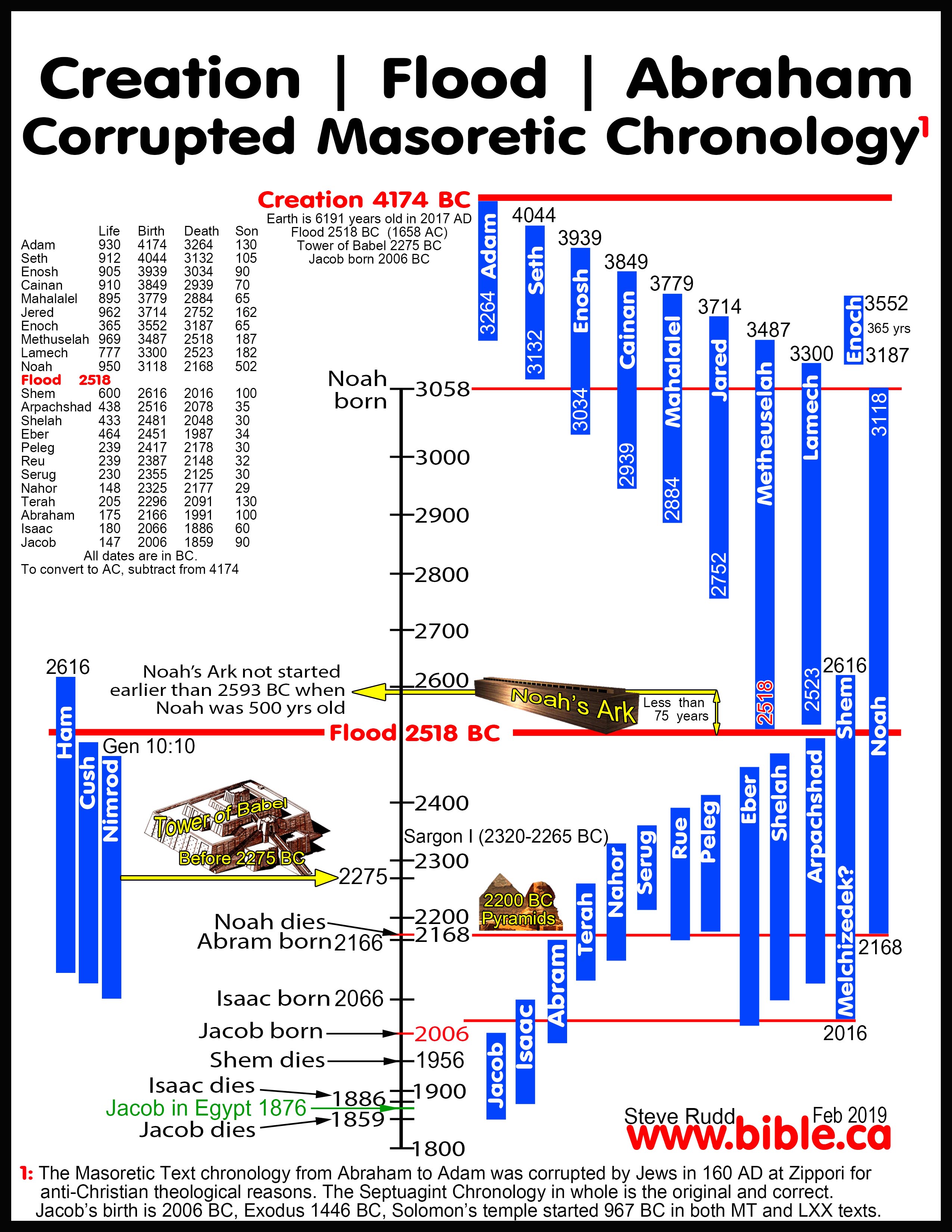
5. Conclusion: The earliest reference to Shem being Melchizedek is the Seder Olam Rabbah in 160 AD which is far to late to validated the Masoretic Hebrew Chronology as original.
a. The Septuagint Chronology of Genesis is original.
b. The Pre-Masoretic Hebrew text (before 160 AD) was original and agreed with the Septuagint
c. The Masoretic Chronology (post 160 AD) of Genesis is corrupt because it exactly mirrors Seder Olam.
I. 100 BC: Jewish Messianic Expectation in the Dead Sea Scrolls: 1QGenesis Apocryphon & 11QMelchizedek
A. 100 BC: Dead Sea Scroll 1QapGen ar (1QGenesis Apocryphon):
1. Dead sea scroll 1QGenesis Apocryphon narrates the story of Melchizedek without any special connection to Shem.
a. This is good evidence that in 100 BC the Jews understood that Shem could not be Melchizedek based upon the chronologies in Gen 11 because he had been dead for hundreds of years.
2. Translation of Dead Sea Scroll: 1QapGen ar (1QGenesis Apocryphon):
a. “The king of Sodom heard that Abram had brought back all the captives and all the loot and went up to meet him. He went to Salem, which is Jerusalem. Abram was encamped in the Valley of Shaveh, which is the Valley of the King, the Valley of Bet ha-Kerem. Melchizedek, king of Salem, brought out food and drink for Abram and for all the men there were with him. He was a priest of the Most High God. He blessed [A]bram and said: Blessed be Abram by the Most High God, Lord of heaven and earth and blessed be the Most High God, who has delivered your enemies into your hands. And he (Abram) gave him a tithe of all the wealth of the king of Elam and his allies. (Dead Sea Scroll, 1QapGen ar Col. Xxii, lines 12-17, 100 BC)
B. 90 BC: Dead Sea Scroll 11Q13 (11QMelch) 11QMelchizedek:
1. Jews expected Melchizedek to return as a “messianic heavenly being”:
a. It is crystal clear that at the time of Christ, the Jews were expecting Melchizedek as messianic figure:
b. Dead sea scroll 11Q13 (11QMelch) features Melchizedek as a divine being (angel etc.) directly connected with the expectation of the Messiah.
c. “Although 1QapGen 22:14–17 retells the story of Melchizedek without elaboration, in 11QMelchizedek (a fragmentary eschatological midrash from the first century A.D. or .B.C..) Melchizedek ceases to be an earthly figure. He rather becomes an angel called “the heavenly one” (˒elōhı̂m, cf. Ps 82:1), and he is a central figure in the eschatological drama. At the end of days he proclaims release to the captives (11QMelch. 2:6; cf. Lev 25:10), exacts “the vengeance of the judgements of God” (11QMelch 2:13) and delivers the sons of light from Belial (11QMelch 2:13).” (Dictionary of the later New Testament and its developments, Melchizedek, p 729, 1997 AD)
2. Translation of Dead Sea Scroll 11Q13 (11QMelch) 11QMelchizedek:
a. “And as for what he said: Lev 25:13 «In [this] year of jubilee, [you shall return, each one, to his respective property», concerning it he said: Deut 15:2 «Th]is is [the manner of the release:] every creditor shall release what he lent [to his neighbour. He shall not coerce his neighbour or his brother, for it has been proclaimed] a release for G[od». Its interpretation] for the last days refers to the captives, who […] and whose teachers have been hidden and kept secret, and from the inheritance of Melchizedek, fo[r …] … and they are the inherita[nce of Melchize]dek, who will make them return. And liberty will be proclaimed for them, to free them from [the debt of] all their iniquities. And this [wil]l [happen] in the first week of the jubilee which follows the ni[ne] jubilees. And the d[ay of aton]ement is the e[nd of] the tenth [ju]bilee in which atonement shall be made for all the sons of [light and] for the men [of] the lot of Mel[chi]zedek. […] … over [the]m … […] accor[ding to] a[ll] their [wor]ks, for it is the time for the «year of grace» of Melchizedek, and of [his] arm[ies, the nat]ion of the holy ones of God, of the rule of judgment, as is written about him in the songs of David, who said: Ps 82:1 «Elohim will [st]and in the assem[bly of God,] in the midst of the gods he judges». And about him he sai[d: Ps 7:8–9 «And] above [it,] to the heights, return: God will judge the peoples». As for what he sa[id: Ps 82:2 «How long will you] judge unjustly and show partia[lity] to the wicked? [Se]lah.» Its interpretation concerns Belial and the spirits of his lot, wh[o …] turn[ing aside] from the commandments of God to [commit evil.] But, Melchizedek will carry out the vengeance of Go[d’s] judgments, [and on that day he will fr]e[e them from the hand of] Belial and from the hand of all the sp[irits of his lot.] To his aid (shall come) all «the gods of [justice»; and h]e is the one w[ho …] all the sons of God, and … […] This […] is the day of [peace about whi]ch he said [… through Isa]iah the prophet, who said: [Isa 52:7 «How] beautiful upon the mountains are the feet [of] the messen[ger who] announces peace, the mess[enger of good who announces salvati]on, [sa]ying to Zion: your God [reigns.»] Its interpretation: The mountains [are] the prophet[s …] … […] for all … […] And the messenger i[s] the anointed of the spir[it] as Dan[iel] said [about him: Dan 9:25 «Until an anointed, a prince, it is seven weeks.» And the messenger of] good who announ[ces salvation] is the one about whom it is written that […] «To comfo[rt] the [afflicted», its interpretation:] to instruct them in all the ages of the wo[rld …] in truth … […] … […] […] has turned away from Belial and will re[turn …] … […] […] in the judgment[s of] God, as is written about him: [Isa 52:7 «Saying to Zi]on: your God rules.» [«Zi]on» i[s] [the congregation of all the sons of justice, those] who establish the covenant, those who avoid walking [on the pa]th of the people. And «your God» is [… Melchizedek, who will fr]e[e them from the ha]nd of Belial. And as for what he said: Lev 25:9 «You shall blow the hor[n in] all the [l]and of […] … […] and know … […] God … […] and many […] […] … […] the law [up]on them […] and he will announce […] [t]he[y] shall devour Belial with fire [… of] Belial shall rebel […] with plot[s] in their hearts […] … it i[s …] the rampart[s] of Judah and … […] the rampart of Jer[usalem …] a wall, and to lift a column and … […] at its appointed time […] […] … […] […] the end of the Ju[bilee …] … […] … […] … [… he] will carry it […] two hundred […] in those […] the week […] … […] [the divi]sions of [the times …] (Dead Sea Scroll, 11Q13, 11QMelch, 11QMelchizedek, Col. ii, lines 1-25; Col. iii frags. 5 + 7, lines 1-20, 100 BC)
II. Ancient literary sources:
1. 170 BC Book of Jubilees:
a. The book of Jubilees has a compressed time scale like the book of Olam Seder but cannot accommodated the idea that Shem was Melchizedek.
b. In the book of Jubilees the flood was in 1308 AC/2598 BC and Abraham was born in 1876 AC/2030 BC which computes to 568 years. Shem lives 502 years after the flood. This means Shem is dies at age 600 and 66 years before Abraham was born. This makes it impossible for Shem to be Melchizedek and explains why Jubilees rehearses the basic Bible story with out embellishments.
c. In fact, the book of Jubilees never names Melchizedek directly but only in a passing reference as a basis for the Levitical tithe:
i. “upon Abram and his seed a tenth of the firstfruits to the Lord. And the Lord ordained it (as) an ordinance forever that they should give it to the priests, to those who minister before him so that they might possess it forever. And there is no limit of days for this law because he ordained it for eternal generations so that they might give one tenth of everything to the Lord: grain and wine and oil and oxen and sheep. And he gave (it) to his priests to eat and drink with rejoicing before him.” (book of Jubilees 13.25–27)
ii. “Jubilees 13.22–29 is a summary of Genesis 14, the wars between the kings. Here again we meet characteristic modifications on the part of the author. Almost all of the Ethiopic manuscripts lack the section of the text where Genesis mentions Melchizedek. It is nearly certain, however, that the Melchizedek section belongs in the text because the preserved parts of Jub. 13.25 with the sequel in vv. 26–27 discuss tithing, a subject mentioned in the Melchizedek pericope. The gap in most of the Ethiopic copies can be explained as a scribal lapse (VanderKam 1989a: 2.81–82). The author uses the Melchizedek passage as the basis for the law of tithing. Abram tithed everything to the priest Melchizedek, according to Gen. 14:20; Jubilees adds: ‘[This tithe was] for Abram and his descendants the tithe of the firstfruits for the Lord. The Lord made it an eternal ordinance that they should give it to the priests who serve before him for them to possess it forever’ (v. 25). The text specifies that a tenth of everything belongs to the Lord, that is, to the priests; ‘seed, the vine, oil, cattle and sheep’ are mentioned (v. 26; see also 32.15). Biblical statements about tithes do not uniformly agree with this prescription. Deuteronomy 12:17–18 orders that the tithe of grain, wine and oil be eaten at the sanctuary by those who bring them (see Deut. 14:22–23, which adds the tithe of the seed). Nehemiah 13:5 refers to ‘the tithes of grain, wine and oil which were given by commandment to the Levites, singers and gate keepers, and the contributions for the priests’ (see also v. 12). The viewpoint expressed in Jubilees—that the priests should receive the tithes—seems a reasonable inference from the Melchizedek story in Genesis but it also reflects the priestly bias of the author.” (The Book of Jubilees, J. C. VanderKam, p48, 2001 AD)
d. While the book of Jubilees has, for the first time, Shem as the firstborn of Noah and older brother of Japheth, it never associates Shem with Melchizedek.
i. “And Noah wrote everything in a book just as we taught him according to every kind of healing. And the evil spirits were restrained from following the sons of Noah. And he gave everything which he wrote to Shem, his oldest son, because he loved him much more than all of his sons.” (Book of Jubilees 10.13–14, 170 BC)
ii. See also: Shem was second-born and NOT Melchizedek
e. This is significant and shows that in 170 BC, the Jews had not yet started teaching the false doctrine that Shem was Melchizedek even though the Jubilees chronology had Shem living at the time of Abraham.
f. When the book of Jubilees was written in 170 BC the Hebrew pre-Masoretic text chronology agreed with the longer ages found in the Septuagint.
2. 100 BC Dead Sea Scrolls of Jewish Targums (commentary on scripture)
a. Although several ancient Targums have been discovered, no fragments of Genesis chapters 5, 11, 14 have been found.
b. If a Targum was found that dates to before Christianity it would validated the Masoretic chronology and the idea that Shem was Melchizedek.
c. However we have found Dead Sea Scroll 11Q13 (11QMelch) 11QMelchizedek which proves that Jews expected Melchizedek to return as a “messianic heavenly being” and did not equate him with Shem.
d. The absence of DSS Targum that say Shem is Melchizedek coupled with the discovery of Dead Sea Scroll 11Q13 that disconnects Shem from Melchizedek is powerful evidence the Jews corrupted their Hebrew Torah in 160 AD.
e. “Early written Palestinian Pentateuch Targums: From Qumran we have evidence that at least some written Targums existed in early times. 11QtargJob may have originated as early as 200 B.C.E., and may have been the same as the Targum of Job known to Rabbi Gamaliel I ( 25-50 c.E.) and his grandson Gamaliel II (90-110 C.E.). The Qumran Job Targum is totally different from the Targum of Job transmitted by rabbinic Judaism and translated in this series. From Qumran we also have sections of a Targum (Aramaic translation) of Lev 16 (4Qtarg Lev), probably from the first century B.C.E. We do not know if it is but a portion of a Targum of all of Leviticus or of the Pentateuch or merely of Lev 16, which was of special liturgical interest. As a text it has similarities to Onqelos” (The Aramaic Bible, The Targum Neofiti Translated with a Critical Introduction Apparatus and Notes, Martin McNamara, Volume 1A to Genesis, p 43, 1992 AD)
3.
160 AD Seder Olam Rabbah: The first literary source on planet earth to equate Shem with
Melchizedek!

a. See full outline: Seder Olam Rabbah
b. EXCERPT FROM SEDER OLAM: “About Shem it says (Gen. 9:26): "Praised be the Eternal, the God of Shem," (Ps. 110:4) "about my word to Malchisedekio [Melchizedek]."” (Seder Olam Rabbah 21:77, 160 AD)
c. Seder Olam equates Shem with Melchizedek to counter the Christian Doctrine that Jesus Christ alone was the type of Melchizedek’s priesthood:
i. In 160 AD, Jews started equating Shem with Melchizedek for the first time in Jewish History, to counter the Christian doctrine that Christ was the type of Melchizedek as seen in the book of Hebrews. It was important to the Jews who just suffered their second major defeat in the second Jewish war of 135 AD that Shem as Melchizedek, conferred priesthood to Abraham. But it was all a fiction created by the Jews in living in Zippori in 160 AD as an anti-Christian revision to counter the idea that Jesus was the messianic type of Melchizedek in the book of Hebrews. The earliest Jewish literary sources (100 BC) make no connection of Shem was Melchizedek as witnessed in the Dead Sea Scrolls: 1QGenesis Apocryphon. At the time of Christ, Jewish messianic expectation was of the arrival of Melchizedek as a “heavenly being” not Shem as witnessed in the Dead Sea Scrolls dating to 90 BC in 11QMelchizedek. The earliest literary source that equates Melchizedek with Shem is Seder Olam Rabbah in 160 AD, then in Targum Onqelos in 225 AD. The Bible clearly teaches in all versions, both Greek Septuagint and Hebrew Masoretic, that Shem was second born of when Noah was 502 years old. The confusion over determining who was the older brother between Shem and Japheth is caused by a minor variant in the Hebrew manuscripts in 160 AD. In Gen 10:21 the LXX indicates Shem was younger than Japheth but the Hebrew wording in the Masoretic makes it uncertain who is older. Some English translators wrongly make Shem the oldest. This minor variant in Hebrew wording is exactly what the Jews wanted to achieve in their anti-Christian revisions of their Hebrew Bible in 160 AD. The Greek LXX calls Japheth “the great” which meant he is both older than Shem or that he was more famous, powerful or richer than Shem. This was simply impossible for the Jews in 160 AD to allow if they wanted to start, for the first time in history, make Shem the GREAT Melchizedek. The Jews wanted to counter the Christian doctrine in the book of Hebrews that Jesus has the priesthood of Melchizedek as the Messianic king/priest/conqueror.
ii. At the time of Christ, Jewish messianic expectation was of the arrival of Melchizedek as a “heavenly being” not Shem as witnessed in the Dead Sea Scrolls: 11QMelchizedek.
iii. "The Lord has sworn and will not change His mind, “You are a priest forever According to the order of Melchizedek.” The Lord is at Your right hand; He will shatter kings in the day of His wrath. He will judge among the nations, He will fill them with corpses, He will shatter the chief men over a broad country. He will drink from the brook by the wayside; Therefore He will lift up His head." (Psalm 110:4–7)
4. 225 AD Targum Onqelos (Aramaic)
a. SHEM = MELCHIZEDEK: “Now Melkhizedek, king of Jerusalem: brought out bread and wine, and he ministered before God Most High. And he blessed him by saying, "Blessed be Abram before God Most High whose possessions are heaven and earth. And blessed be God Most High who had delivered your enemy into your hand and has given him a tenth of everything." (The Aramaic Bible, The Targum Onqelos Translated with a Critical Introduction Apparatus and Notes, Bernard Grossfeld, Michael Glazier, Volume 6 to Genesis, Translation of Gen 14:18-20, p 68, 1988 AD)
b. The prevailing view is that Onqelos is the same person as Aquila whom Justin Martyr battled:
i. "Aquila’s name must have been common in antiquity since it is attested in the apostolic age. This translator was a gentile by birth and came from Sinope, a Roman colony in Pontus. Epiphanius provides more details about his life. He lived during the reign of the emperor Hadrian (117–138) to whom he was related (he was probably his brother-in-law: πενθερίδης, The Dialogue of Timothy and Aquila, 117; πενθερός according to Pseudo-Athanasius in the Chronicon Pascale). Hadrian commissioned him to supervise the building of Aelia Capitolina on the esplanade of Jerusalem and there he was converted to Christianity under the influence of those returning from Pella. However, he was excommunicated [by Christians] since he refused to give up astrology. Out of resentment he underwent circumcision, devoting himself to learning Hebrew in order to translate the Bible into Greek with the aim of displacing the LXX which at the time represented Christian interpretation." (The Septuagint in Context: Introduction to the Greek Version of the Bible, Marcos, N. Fernández, p111, 2000 AD)
c. Apart from the Dead Sea Scrolls, Targum Onqelos is the earliest Jewish commentary extant and notice it DOES NOT DIRECTLY connect Shem with Melchizedek as later Targum do.
i. However, the Hebrew word “ministered” is not in ANY bible manuscript but is a Jewish commentary (Targum) on the role of Melchizedek connecting him with the Aaronic priesthood. The use of this special Hebrew word was calculated to directly associate Melchizedek with the Levitical priesthood conferred upon Abraham.
1. "the woven garments as well, and the holy garments for Aaron the priest, and the garments of his sons, with which to carry [literally: serve] on their priesthood;" (Exodus 31:10)
2. "‘This is that which is consecrated to Aaron and that which is consecrated to his sons from the offerings by fire to the Lord, in that day when he presented them to serve as priests to the Lord." (Leviticus 7:35)
3. "These are the names of the sons of Aaron, the anointed priests, whom he ordained to serve as priests." (Numbers 3:3)
ii. “The Hebrew: "he was a priest" is here interpretively rendered by the verbal equivalent of Hebrew khn which is here rendered Sm.§ "to serve"/"to minister" also in Exod 31:10; Lev 7:35, Num 3:3 et al by Onqelos. This interpretation was deliberate in view of the identification of Melchizedek as Shem son of Noah (for which cf. L. Ginzberg, Legends of the Jews V, op. cit., pp. 192, 225-6) who in turn became a prototype of Jesus in Christian literature (for which cf. the NT Book of Hebrews 5:5-6, 7:15-17 and Y. Yadin, "A Note on Melchizedek and Qumran IEJ 15 [1965]:152 ff.; and J. Fitzmyer, "Further Light on Melchizedek from Qumran Cave II"JBL 86 [1967]:25-41. This interpretation is supported by a variety of Rabbinic sources—b. Ned. 32b; Lev. Rab. XXV:6, 18, p. 580, and especially Num. Rab. IV:8 and PRE VIII. (The Aramaic Bible, The Targum Onqelos Translated with a Critical Introduction Apparatus and Notes, Bernard Grossfeld, Michael Glazier, Volume 6 to Genesis, Translation of Gen 14:18-20, footnote 17, p 69, 1988 AD)
d. “Most scholars date the final redaction to the third century C.E. with the main evidence being the masorah, which dates to the first half of that century. This masorah includes divergencies in wordings between the Sura and Nehardea academies of Babylinia, the later destroyed in 268 C.E. It was first published by Berliner and then as a lexicon by S. Landauer. Kahlehs and A. Diez Macho point to the masorah as significant evidence for the final redaction of TO in the third century C.E. The authorship of TO is attributed to one Onyelos the Proselyte, nephew of Titus (b. Git. 56B). or of Hadrian (Tanh (A) Mishpatim V), who was a disciple and contemporary of R. Eliezer ben Hyrcanus, R. Joshua b. Hananiah or even R. Aqiba. The overwhelming number of parallels between Targum Onyelos and the Halakhic Midrashim—Mekhilta, Sifra, and Sifre—both with regards to Halakhic and Aggadic interpretations, definitely point in the direction of a common tradition upon which both genres' Scriptural interpretation rest. The common tradition is that of Rabbi Aqiba. The only primary source which can be taken into consideration is the Jerusalem Talmud. According to the statement of R. Jose in the name of R. Johanan: "Aqylas the proselyte trgm in the presence of R. Aqiba." Two things must be kept in mind. First, in order to utilize this passage as evidence for an Onqelos-Aqilas association, one must first make the identification that Aqylas in the Jerusalem Talmud is one and the same person as Onqelos in the Babylonian Talmud. (Meg. 3b)” That identification appears to be the consensus of scholars. Second, the meaning of the verb trgm, "translate" (in an interpretive manner); now, the basis of Onqelos' translation of the Scriptural passages which contain Halakhic and Aggadic material is precisely interpretation. What is more, the method of interpretation employed in Sifra to Leviticus and Sifre to Deuteronomy is definitely that of the School of R. Aqiba. What concerns the parallels to the Mekhilta of R. Ishmael on Exodus and to Sifry on Numbers, Midrashim of the School of R. Ishmael, equivalent passages occur for the most part in the School of R. Aqiba Midrashim, to Mekhilta of R. Simeon b. Yohai on Exodus, and to Sifre Zuta on Numbers, both of whose authorship is attributed by Hoffmann to R. Simeon b. Yohai, the most distinguished disciple of R. Aqiba. To be sure, there are occasional exceptions where TO reflects the interpretations of R. Ishmael's School. This by no means invalidates the contention that Onqelos followed a R. Aqiba tradition more than any other Tannaitic point of view. In fact, even the Mekhilta of R. Ishmael occasionally includes R. Aqiba's teachings. In non-controversial matters, there is no decisive evidence that TO followed one school rather than another. Only where these two schools differ from one another does TO uphold the views of R. Aqiba's School. In general, the problem of Halakhic or Aggadic preference would arise only on relatively rare instances, and the normally accepted procedure for an official translation of the Pentateuch was to render the sense of the Hebrew text both idiomatically and as close as possible to the literal meaning, but without being enslaved to it. These situations then would lead one to date the original composition of the Aramaic Version of the Torah known to us as Targum Onqelos to a period somewhere between the beginning to the middle of the 2nd century C.E. in Palestine which Goshen‑Gottstein called Proto-Onqelos. This is not to say that the proselyte Onqelos started from scratch in creating such a translation. There are sufficient amount of references scattered throughout Rabbinic literature that lead us to believe that an Aramaic Pentateuch translation, perhaps even more than one, were in circulation in Palestine.” (The Aramaic Bible, The Targum Onqelos Translated with a Critical Introduction Apparatus and Notes, Bernard Grossfeld, Michael Glazier, Volume 6 to Genesis, p 32, 1988 AD)
5. 350 AD Targum Neofiti (Aramaic)
a. SHEM = MELCHIZEDEK: "And the king of Sodom came out to meet him, after he had returned from slaying Chedorlaomer and the kings who were with him, in the Valley of the Orchards, that is, the valley of the king. And Melchisedech, king of Jerusalem—he is Shem the Great—brought out bread and wine, for he was the priest who ministered in the high priesthood before the most High God. And he blessed him and said: “Blessed is Abram before the most High God who by his Memra created the heavens and the earth; and blessed is the most High God who crushed your enemies before you.” And he gave him a tithe of everything. And the king of Sodom said to Abram: “Give me the persons and take the wealth for yourself.”" (The Aramaic Bible, The Targum Neofiti Translated with a Critical Introduction Apparatus and Notes, K. Cathcart, M. Maher, Martin McNamara, Volume 1A to Genesis, Translation of Gen 14:17-21, p 92, 1992 AD)
b. Aramaic text: ומלכא צדק מלכא דירושלם הוא שם רובה אפק לחם וחמר והוא הוה כהן משמש בכהנת׳ רבתה קדם אלהא עלאה׃ (Targum Neofiti to the Pentateuch, Hebrew Union College, Genesis 14:18, 2005 AD)
c. “AGE AND ORIGIN OF THE PALESTINIAN PENTATEUCH TARGUMS: In this introduction we are dealing with the Palestinian Targums as known to us through the extant sources: the entire text in Codex Neofiti, partial Cairo Genizah texts, Fragment Targums, Targumic Tosefoth, early and medieval citations. These are written texts, literature, not oral tradition. We have also seen that these texts have in general been translated from the Hebrew with no small amount of thought and art; variant traditions among them have a certain unity of translation procedures which set them off from other translations within the same tradition. This again is evidence that we are here dealing with literature, not ad hoc synagogue translations. Through the extant manuscripts and citations we can trace the history of this Targum tradition from the more recent manuscripts of the sixteenth century back to the eighth and possibly earlier. We now examine whether we can go beyond this. … We have very strong evidence from rabbinic sources that written texts of the Targums of the Pentateuch (therefore Palestinian Targums) existed at least in the late third and early fourth centuries of our era, and there are indications that they were known there earlier still. Written Targums are legislated for in the Mishnah, Yadaim 4:5. In b. Berakoth 8a we read of the advice given by R. Joshua ben Levi (ca. 250 c.e.) to his children on how to prepare the parashah, i.e., the weekly section of the Pentateuch read in the synagogue: “Even so did Joshua ben Levi say to his children: ‘Complete your parashah together with the congregation, twice the Hebrew Text and once the Targum.’ ” The same advice was given by R. Ammi (ca. 300 c.e.) to all Jews, according to the same text (b. Berakoth 80ab): “R. Huna ben Judah says in the name of R. Ammi: ‘A man should always complete his parashah together with the congregation, twice the Hebrew text and once the Targum, even such verses as Ataroth and Dibon (Num 32:3), for if one completes his parashah together with the congregation his days will be prolonged.’ ” These texts are best understood if written rather than oral Targums are intended. And, in point of fact, those who examine this evidence tend to see here references to written Targums. Some texts connected with R. Samuel bar R. Isaac clearly indicate the use of written Targums in Palestine in the early fourth century. In j. Megillah IV, 1 (74d, top, ed., Krotoschin) we read: “R. Samuel bar R. Isaac entered a synagogue (and) saw a certain man translating while leaning against a pillar. He said to him: ‘It is forbidden to you! Just as it was given in awe and reverence, thus we have to treat it with awe and reverence.’ ” The point being made, it would appear, is that the Targum merits the same respect as the Law itself. In b. Berakoth 45a we read again of R. Samuel: “R. Samuel bar R. Isaac entered the synagogue (and) saw a certain teacher interpreting the Targum from the book. He said to him: ‘It is forbidden to you! Matters which are transmitted orally (should remain) oral; matters which are (transmitted) in writing (should remain) in writing.’ ” As Anthony D. York remarks on this passage, “Among the several interesting features of this passage, we should observe first of all that a written Targum was in use in the synagogue early in the fourth century”—a point that fits in well with the evidence we have seen from R. Ammi, R. Samuel’s contemporary. 2. Likelihood of transmission to us of fourth-century Targums With regard to the likelihood of Palestinian Targum texts of the fourth century c.e. or earlier having been faithfully transmitted to the sixteenth, we should judge from the case of the Cairo Genizah text E Targum. This unfortunately is extant only for Genesis, and then only in fragmentary fashion: Gen 6:18–7:15; 9:5–23; 28:17–29:17; 29:17–30:2; 30:43–31:15; 31:15–31:22; 38:16–39:10; 41:6–41:26; 43:30–44:4. P. Kahle in 1930 dated this manuscript to 750–800 c.e. The leading present-day palaeographer, Professor Malachi Beit Arié, can be no more precise in his dating than “early,” i.e., ninth/tenth to mid-eleventh century c.e. The fact, however, that a text of this particular Pal. Tg., or more probably a sister copy of it, is reproduced almost verbatim in the marginal glosses of Neofiti (copied 1504 AD) shows how an early text was faithfully transmitted. 3. Arguments linking our present Pal. Tg. texts with fourth-century Palestine or earlier The rabbinic citations already considered, when taken with the arguments for fidelity of transmission, present fairly strong grounds for seeing continuity between our present texts with fourth-century Palestine or earlier. The arguments appear strongest for an early date for the Targum of Codex Neofiti 1. To the rabbinic citations already noted we should add an extremely interesting text of Jerome. In his Hebraicae quaestiones in Gen. 8:6 he says: “Post quadraginta dies aperuit Noe ostium arcae … Pro ostio fenestra scripta est in hebraeo.” (“After forty days Noah opened the door of the Ark. For ‘door’ in Hebrew we find written ‘window.’ ”) The Hebrew text (ḥlwn) and Jerome’s Vulgate rendering of it, have “window,” not “door.” Nor does any known translation have “door,” apart from Neofiti, which Neofiti reading some scholars have regarded as a textual error. Could it be that the late fourth-century scholar Jerome had access to the original of Neofiti or to a Neofiti-type text? Much more study will be required before we can safely say that the Palestinian Targums, at least of the Neofiti type, can be assigned to the fourth century, e.g., examination of the Greek and Latin loan words to ascertain when they were current; more detailed examination of the form of the Aramaic used.” (The Aramaic Bible, The Targum Neofiti Translated with a Critical Introduction Apparatus and Notes, K. Cathcart, M. Maher, Martin McNamara, Volume 1A to Genesis, p 44, 1992 AD)
6. 373 AD Ephrem the Syrian:
a. Ephrem the Syrian was born about 306 and active 363-373
b. He was a Syrian writer of commentaries and devotional hymns which are sometimes regarded as the greatest specimens of Christian poetry prior to Dante.
c. “Some say that this Melchizedek was actually Shem, son of Noah; in fact, they say the book of Genesis clearly shows that he lived in the days of Abraham and Isaac and Jacob. Moreover, from the sortitions of those tribes who inherited the land of the house of Shem, it looks clear that he lived in Salem in his own inheritance. Not only Melchizedek but also the name Melchizedek are “without father, and mother and without genealogy” because neither the name Melchizedek nor the name Israel were written in the genealogy, whereas Shem and Jacob had father and mother, and a beginning and an end, and were inscribed in the genealogy. But the names of Melchizedek and Israel did not have any of these things. God glorified them both with names equally imposed by him. He “was made similar to the Son of God” through his priesthood, so that the priesthood of Melchizedek might last forever, not in Melchizedek himself but in the Lord of Melchizedek. And the apostle highly praises the priesthood of all nations rather than that of his people, when he says, “Consider how great this man is to whom even our patriarch Abraham gave the tenth part of everything.” (Ephrem the Syrian, Commentary on the Epistle to the Hebrews, 373 AD)
d. “This Melchizedek is Shem, who became a king due to his greatness; he was the head of fourteen nations. In addition, he was a priest. He received this from Noah, his father, through the rights of succession. Shem lived not only to the time of Abraham, as Scripture says, but even to the time of Jacob and Esau, the grandsons of Abraham. It was to him that Rebekah went to ask and was told, “Two nations are in your womb, and the elder shall serve the younger.” Rebekah would not have bypassed her husband, who had been delivered at the high place, or her father-in-law, to whom revelations of the divinity came continually, and gone straight to ask Melchizedek unless she had learned of his greatness from Abraham or Abraham’s son. Abraham would not have given him a tenth of everything unless he knew that Melchizedek was infinitely greater than himself. Would Rebekah have asked one of the Canaanites or one of the Sodomites? Would Abraham have given a tenth of his possessions to any one of these? One ought not even entertain such ideas. Because the length of Melchizedek’s life extended to the time of Jacob and Esau, it has been stated, with much probability, that he was Shem. His father Noah was dwelling in the east, and Melchizedek was dwelling between two tribes, that is, between the sons of Ham and his own sons. Melchizedek was like a partition between the two, for he was afraid that the sons of Ham would turn his own sons to idolatry. (Ephrem the Syrian, Commentary on Genesis 11.2.2-4, 373 AD).
7. 400 AD Jerome:
a. Jerome was a gifted exegete and exponent of a classical Latin style
b. Jerome is best known as the translator of the Latin Vulgate.
c. He defended the perpetual virginity of Mary, attacked Origen and Pelagius and supported extreme ascetic practices.
d. “The Jews say that Melchizedek was Shem, Noah’s son, and, counting up the total years of his lifetime, they demonstrate that he would have lived up to the time of Isaac; and they say that all the firstborn sons of Noah were priests before Aaron performed the priestly office. Also, by “king of Salem” is meant the king of Jerusalem, which was formerly called Salem. And the blessed apostle writing to the Hebrews makes mention of Melchizedek as “without father or mother” and refers him to Christ and, through Christ, to the church of the Gentiles, for all the glory of the head is assigned to the members.… While he was uncircumcised, he blessed Abraham who had been circumcised; and in Abraham he blessed Levi; and through Levi he blessed Aaron from whom the priesthood afterwards descended. For this reason, he maintains, one should infer that the priesthood of the church, which is uncircumcised, blessed the priesthood of the synagogue, which is circumcised. And as to the Scripture which says, “You are a priest forever after the order of Melchizedek,” our mystery is foreshown in the word order; not at all, indeed, in the sacrifice of nonrational victims through Aaron’s agency, but when bread and wine, that is, the body and blood of the Lord Jesus, were offered in sacrifice. (Jerome, Hebrew Questions on Genesis 14.18-19, 400 AD)
8. 400 AD Epiphanius of Salamis on Cypress Island:
a. Epiphanius of Salamis was the Bishop of Salamis in Cyprus.
b. Epiphanius of Salamis was the author of a refutation of eighty heresies (the Panarion).
c. Epiphanius of Salamis was instrumental in the condemnation of Origen.
d. In the excerpt below, Epiphanius of Salamis must have been confused. He accuses the Samaritans living in Judea (the area of Shechem up to Zippori etc) of having no scriptural support for Shem living long enough to be Melchizedek. The problem is that the Samaritan Pentateuch chronology of Gen 11 from Shem to Abraham is 1100 years (LXX = 1230 years). The Samaritan Pentateuch corrupted the Gen 5 Chronology by reducing the timespan from Creation to Noah from 2158 years down to 1209 years. So, it cannot be the Samaritans who are claiming Shem is Melchizedek. Instead, Epiphanius must have confused the Jews living near Zippori and Tiberias to be Samaritans. After all, who else would come up with the new and strange idea that Shem was Melchizedek? What is also instructive, is that Epiphanius who was stationed at Salamis on the Island of Cypress, was unaware that the Hebrew Masoretic text had been corrupted 150 hundred years earlier by the Jews at Zippori.
e. “And how many things about this Melchizedek others also imagine! The Samaritans, for example, consider him to be Shem, the son of Noah; but they, too, will be found to be absurd. For the sacred Scripture, which safeguards everything with good order, has fortified the truth from all sides, and it has not set the order of the times and the years of the lives of each of the patriarchs and enumerated their successions in vain. After all, when Abraham was eighty-eight or, more or less, ninety years old, Melchizedek met him and offered him loaves of bread and wine, prefiguring the mysteries through the types; types, that is, of the Lord’s body—since the Lord himself says, “I am the living bread”—and types of his blood, which flowed from his side for the cleansing of those who have been defiled and the sprinkling and salvation of our souls.…Shem, however, of whom we spoke before, and whom the Samaritans imagine to be Melchizedek, fathered Arpachshad in the one hundred second year of his life, and altogether there were 1,241 years until the time of Abraham, when he met Melchizedek on his return from the slaughter of the kings,36 Amraphel, Arioch, Chedorlaomer, and Tidal. And Shem did not live as many years as their silly imagination thinks, but he was 102 years old when he fathered Arpachshad, in the second year after the flood. “And after these events, he lived,” as the sacred Scripture says, “for five hundred years, and had other sons and daughters, and he died.” Now then, since he lived for 602 years and then died, how is it possible for him to reach the span of 1,241 years, so that Shem, the son of Noah, who preceded Abraham by ten generations, may be called Melchizedek by them, after ten generations, after 1,241 years? O, the great deceit of men! And according to the evidence of other manuscripts, from the age of Shem—from the time in which Shem lived—until the time at which Abraham met Melchizedek, as was stated before, which was during [Abraham’s] eighty-eight or ninetieth year of life, 628 years passed, more or less. All of this evidence, therefore, means that it is impossible for Shem to have reached the period of Abraham, so as to be identified with Melchizedek. Thus, the nonsense of the Samaritans is destroyed in every way. Panarion 4, Against Melchizedekians 6.1–11. (Epiphanius of Salamis, 400 AD)
9. 500 AD Babylonian Talmud:
a. 500 AD: "I.18 A. Said R. Zechariah in the name of R. Ishmael, “The Holy One, blessed be He, wanted to bring forth the priesthood through Shem: ‘And he, Melchizedek, was the priest of the most high God’ (Gen. 14:18). But, because he gave priority, when he bestowed his blessing, to Abraham over God, he brought the priesthood forth through Abraham: ‘And he blessed him and said, blessed be Abram of the most high God, who holds heaven and earth, and also blessed be the most high God’ (Gen. 14:19–20). (Babylonian Talmud. Ned. 3:11g, I.18.A, 500 AD)
10. 900 AD Targum Pseudo-Jonathan (Aramaic)
a. SHEM = MELCHIZEDEK: "When he returned from defeating Chedorlaomer and the kings who were with him, the king of Sodom came out to meet him at the leveled plain, which is the king’s racecourse. The righteous king—that is Shem, the son of Noah—king of Jerusalem, went out to meet Abram, and brought him bread and wine; at that time he was ministering before God Most High. He blessed him and said, “Blessed be Abram from (before) God Most High, who created the heavens and the earth for the sake of the righteous. And blessed be God Most High, who has made those who hate you like a shield that receives a blow.” And he gave him a tithe of all that he had brought back. The king of Sodom said to Abram, “Give me the human persons of my people whom you brought back, and the possessions take for yourself.”" (The Aramaic Bible, The Targum Pseudo-Jonathan Translated with a Critical Introduction Apparatus and Notes, K. Cathcart, Michael Maher, Martin McNamara, Volume 1B Genesis, Translation of Genesis 14:17–21, p 58, 1992 AD)
b. DATING Targum Pseudo-Jonathan: “The Date of Targum Pseudo-Jonathan: My purpose here is not to record or discuss all the views that have been expressed on this matter but rather to state what is the more commonly accepted view today. Although Pseudo-Jonathan certainly contains ancient traditions, many recent authors argue that this Targum received its final form after the Arab conquest of the Middle East. D. M. Splansky believes that Pseudo-Jonathan dates from the ninth or tenth century. His main arguments may be summarized as follows: The reference to Adisha and Fatima in Pseudo-Jonathan Gen 21:21 should not be seen as an insertion. The source of the midrash could not have originated before 633 c.e at the earliest. Pseudo-Jonathan makes use of PRE and both Tanḥumas, a fact which points to the ninth or tenth century as the time of Pseudo-Jonathan ’s compilation. The way in which Pseudo-Jonathan presents the midrash about Abraham’s refusal to bless Ishmael in Gen 25:11 betrays an anti-Moslem polemic, and the reference to the blemish of Ishmael and the blemish of Esau in Pseudo-Jonathan Gen 35:22 [“Woe! Perhaps an unworthy person has gone forth from me, as Ishmael went forth from Abraham and Esau went forth from my father.”] can best be explained against the background of a world divided between Arabs and Christians. There are possible indications in other texts in Pseudo-Jonathan (e.g., Gen 16:12; 25:13 [“the first-born of Ishmael, the Arab”]; 49:26; Num 7:87) that they date from a time after the Arab conquest. The precise reference to calendar matters in Pseudo-Jonathan Gen 1:16 shows that this Targum was written in the second half of the ninth century at the earliest. Shinan has also stated his conviction that Pseudo-Jonathan depends on PRE and that it is the work of an author-editor who was active in the seventh or eighth century. Le Déaut affirms that the final redaction of Pseudo-Jonathan could not have taken place before the eighth century. Cook’s examination of the language of Pseudo-Jonathan leads him to conclude that there are a number of indications which place Pseudo-Jonathan after the Muslim conquest of the East. J. A. Foster, on the basis of the language of Pseudo-Jonathan , states that this Targum may date from the eighth or ninth century. The findings of these and other scholars who have dedicated special studies to both the content and the language of Pseudo-Jonathan allow us to accept with confidence the view that this Targum in its final form cannot be dated before the seventh or eighth century.” (The Aramaic Bible, The Targum Pseudo-Jonathan Translated with a Critical Introduction Apparatus and Notes, K. Cathcart, Michael Maher, Martin McNamara, Volume 1B Genesis, p 12, 1992 AD)
c. References to post-Islamic invasion of Muhammad in 649 AD:
i. "The Memra of the Lord was at the assistance of the boy, and he grew up. He dwelt in the wilderness and became a skilled bowman. He dwelt in the desert of Paran and took as wife Adisha. But he divorced her, and his mother took Fatima as wife for him from the land of Egypt." (The Aramaic Bible, The Targum Pseudo-Jonathan Translated with a Critical Introduction Apparatus and Notes, K. Cathcart, Michael Maher, Martin McNamara, Volume 1B Genesis, Translation of Gen 21:20-21, p 76, 1992 AD)
ii. “This mention of the names Adisha and Fatima, the wife and daughter of Mohammad, is often used as proof of the contention that Pseudo-Jonathan , at least in its final form, cannot be dated earlier than the seventh century c.e; cf., e.g., Seligsohn-Traub, 1857, 110; Splansky, 1981, 89. H. Z. Hirschberg, (“The Place of the Aramaic Targumim in the Life of the People” [in Hebrew], Bar Ilan, 1 [1963] 21) maintains that this midrash dates from the second half of the tenth century. The names Adisha (Ayisha) and Fatima are not mentioned in any Targum except Pseudo-Jonathan Ayisha was, in fact, Mohammad’s favorite wife, while Fatima was his daughter. The tradition recorded here by Pseudo-Jonathan is preserved at greater length in PRE 30 (218–219).” (The Aramaic Bible, The Targum Pseudo-Jonathan Translated with a Critical Introduction Apparatus and Notes, K. Cathcart, Michael Maher, Martin McNamara, Volume 1B Genesis, Translation of Gen 21:21, footnote 27, p 76, 1992 AD)
d. Knowledge of calendar of 835 AD:
i. "God made the two great lights, and they were equal in glory for twenty-one hours less six hundred and seventy-two parts of an hour. After that the moon spoke with a slanderous tongue against the sun, and it was made smaller. And he appointed the sun which was the greater light to rule over the day, and the moon which was the lesser light <to rule over the night>, and the stars." (The Aramaic Bible, The Targum Pseudo-Jonathan Translated with a Critical Introduction Apparatus and Notes, K. Cathcart, Michael Maher, Martin McNamara, Volume 1B Genesis, Translation of Gen 1:16, p 18, 1992 AD)
ii. “We read “hours” (š‘yn) with Lond., rather than “years” (šnyn) of ed. pr. On the calendar details expressed in this verse in Ps.-J., see Splansky, 1981, 100–105. According to Splansky, Ps.-J.’s version of Gen 1:16 shows that the author had precise knowledge of calendar calculations which were not known to the Jews before 835 c.e. There is no known source for Ps.-J.’s statement that the sun and moon were equal for twenty-one hours less 672 parts of an hour; cf. Brayer, 1964, 204.” (The Aramaic Bible, The Targum Pseudo-Jonathan Translated with a Critical Introduction Apparatus and Notes, K. Cathcart, Michael Maher, Martin McNamara, Volume 1B Genesis, Translation of Gen 1:16, footnote 28, p 18, 1992 AD)
III. Modern literary sources:
1. The Jewish Rabbis today believe and teach that Shem was Melchizedek as seen from this famous fictional novel written in 1909 AD.
2. 1909 AD: “In spite of his great success, Abraham nevertheless was concerned about the issue of the war. He feared that the prohibition against shedding the blood of man had been transgressed, and he also dreaded the resentment of Shem, whose descendants had perished in the encounter. But God reassured him, and said: “Be not afraid! Thou hast but extirpated the thorns, and as to Shem, he will bless thee rather than curse thee.” So it was. When Abraham returned from the war, Shem, or, as he is sometimes called, Melchizedek, the king of righteousness, priest of God Most High, and king of Jerusalem, came forth to meet him with bread and wine. And this high priest instructed Abraham in the laws of the priesthood and in the Torah, and to prove his friendship for him he blessed him, and called him the partner of God in the possession of the world, seeing that through him the Name of God had first been made known among men.103 But Melchizedek arranged the words of his blessing in an unseemly way. He named Abraham first and then God. As a punishment, he was deposed by God from the priestly dignity, and instead it was passed over to Abraham, with whose descendants it remained forever.” (Legends of the Jews, L. Ginzberg, H. Szold, P. Radin, Jewish Publication Society, p 196, 2003 AD, 1909 AD)
IV. Modern commentators:
1. "The identity of Melchizedek with Shem is presupposed in many Jewish and Christian sources; comp. Nedarim 32b; BR 26.4 and the parallel passages given by Theodor; Tehillim 76, 340; PRE 8 and 27; Yelammedenu quoted in Yalkut Nahum (here שלם = perfect, free from any blemish)" (Legends of the Jews, L. Ginzberg, H. Szold, P. Radin, Jewish Publication Society, p 196, 2003 AD, 1909 AD)
2. “Both the second-century Aramaic Targum Neofiti and the Fragment Targum identify Melchizedek with Noah’s son Shem in its translation of Genesis 14:18: “The king of Righteousness (Melka-sedek), the king of Jerusalem—he is Shem, the great one—brought out bread and wine, for he was the priest who served in the High Priesthood before the Most High God” (also the later Targum Pseudo-Jonathan). (Dictionary of New Testament background, Melchizedek, Traditions of, p 694, 2000 AD)
3. "Jerome (400 AD) and Ephrem (the Syrian 363 AD) allow for a possibility that Melchizedek was Shem". (ACCS, E. M. Heen, p v, 2005 AD)
V. 30 AD: Jesus Christ was exactly the type of Melchizedek the Jews were looking for:
1. In 90 BC down to the time of Jesus, the Jews expected Melchizedek to return as a “messianic heavenly being”: 90 BC: Dead Sea Scroll 11Q13 (see below)
2. "The Lord has sworn and will not change His mind, “You are a priest forever According to the order of Melchizedek.” The Lord is at Your right hand; He will shatter kings in the day of His wrath. He will judge among the nations, He will fill them with corpses, He will shatter the chief men over a broad country. He will drink from the brook by the wayside; Therefore He will lift up His head." (Psalm 110:4–7)
3. "just as He says also in another passage, “You are a priest forever According to the order of Melchizedek.” In the days of His flesh, He offered up both prayers and supplications with loud crying and tears to the One able to save Him from death, and He was heard because of His piety. Although He was a Son, He learned obedience from the things which He suffered. And having been made perfect, He became to all those who obey Him the source of eternal salvation, being designated by God as a high priest according to the order of Melchizedek. Concerning him we have much to say, and it is hard to explain, since you have become dull of hearing." (Hebrews 5:6–11)
4. "This hope we have as an anchor of the soul, a hope both sure and steadfast and one which enters within the veil, where Jesus has entered as a forerunner for us, having become a high priest forever according to the order of Melchizedek. For this Melchizedek, king of Salem, priest of the Most High God, who met Abraham as he was returning from the slaughter of the kings and blessed him, to whom also Abraham apportioned a tenth part of all the spoils, was first of all, by the translation of his name, king of righteousness, and then also king of Salem, which is king of peace. Without father, without mother, without genealogy, having neither beginning of days nor end of life, but made like the Son of God, he remains a priest perpetually. Now observe how great this man was to whom Abraham, the patriarch, gave a tenth of the choicest spoils. And those indeed of the sons of Levi who receive the priest’s office have commandment in the Law to collect a tenth from the people, that is, from their brethren, although these are descended from Abraham. But the one whose genealogy is not traced from them collected a tenth from Abraham and blessed the one who had the promises. But without any dispute the lesser is blessed by the greater. In this case mortal men receive tithes, but in that case one receives them, of whom it is witnessed that he lives on. And, so to speak, through Abraham even Levi, who received tithes, paid tithes, for he was still in the loins of his father when Melchizedek met him. Now if perfection was through the Levitical priesthood (for on the basis of it the people received the Law), what further need was there for another priest to arise according to the order of Melchizedek, and not be designated according to the order of Aaron? For when the priesthood is changed, of necessity there takes place a change of law also. For the one concerning whom these things are spoken belongs to another tribe, from which no one has officiated at the altar. For it is evident that our Lord was descended from Judah, a tribe with reference to which Moses spoke nothing concerning priests. And this is clearer still, if another priest arises according to the likeness of Melchizedek, who has become such not on the basis of a law of physical requirement, but according to the power of an indestructible life. For it is attested of Him, “You are a priest forever According to the order of Melchizedek.” For, on the one hand, there is a setting aside of a former commandment because of its weakness and uselessness (for the Law made nothing perfect), and on the other hand there is a bringing in of a better hope, through which we draw near to God. And inasmuch as it was not without an oath (for they indeed became priests without an oath, but He with an oath through the One who said to Him, “The Lord has sworn And will not change His mind, ‘You are a priest forever’ ”); so much the more also Jesus has become the guarantee of a better covenant. The former priests, on the one hand, existed in greater numbers because they were prevented by death from continuing, but Jesus, on the other hand, because He continues forever, holds His priesthood permanently. Therefore He is able also to save forever those who draw near to God through Him, since He always lives to make intercession for them. For it was fitting for us to have such a high priest, holy, innocent, undefiled, separated from sinners and exalted above the heavens; who does not need daily, like those high priests, to offer up sacrifices, first for His own sins and then for the sins of the people, because this He did once for all when He offered up Himself. For the Law appoints men as high priests who are weak, but the word of the oath, which came after the Law, appoints a Son, made perfect forever." (Hebrews 6:19–7:28)
Conclusion:
1. The earliest reference to Shem being Melchizedek is the Seder Olam Rabbah in 160 AD which is far to late to validated the Masoretic Hebrew Chronology as original.
a. The Septuagint Chronology of Genesis is original.
b. The Pre-Masoretic Hebrew text (before 160 AD) was original and agreed with the Septuagint
c. The Masoretic Chronology (post 160 AD) of Genesis is corrupt because it exactly mirrors Seder Olam.
2. Shem as Melchizedek who conferred priesthood to Abraham was a fiction created by the Jews in 160 AD as an anti-Christian revision to counter the idea that Jesus was the messianic type of Melchizedek in the book of Hebrews.
a. 100 BC: The earliest Jewish literary sources make no connection of Shem was Melchizedek as witnessed in the Dead Sea Scrolls: 1QGenesis Apocryphon.
b. At the time of Christ, Jewish messianic expectation was of the arrival of Melchizedek as a “heavenly being” not Shem as witnessed in the Dead Sea Scrolls: 11QMelchizedek.
c. 160 AD: The earliest literary source that equates Melchizedek with Shem is Seder Olam Rabbah in 160 AD, The Seder Olam again, is the first reference in history and was the basis for corrupting the pre-Masoretic text in the chronologies of Gen 5 and 11.
3. The other change the Jews made to the Hebrew Text of their Bible, was making Shem firstborn and “the great” over his brother Japheth:
a. See also: Shem was second-born and NOT Melchizedek.
b. Japheth “the Great” was firstborn in the LXX. They couldn’t suddenly redefine Shem as Melchizedek if his older brother Japheth was called “the great” in both the Greek Septuagint and the Hebrew pre-Masoretic text (MT)
|
Jesus, High Priest forever, after the order of Melchizedek High Priest, Jesus calls Jew and Gentile to salvation through his atoning blood sacrifice: "In the same way God, desiring even more to show to the heirs of the promise the unchangeableness of His purpose, interposed with an oath, so that by two unchangeable things in which it is impossible for God to lie, we who have taken refuge would have strong encouragement to take hold of the hope set before us. This hope we have as an anchor of the soul, a hope both sure and steadfast and one which enters within the veil, where Jesus has entered as a forerunner for us, having become a high priest forever according to the order of Melchizedek." (Hebrews 6:17–20) |
|
The Septuagint LXX “Scripture Cannot Be Broken” |
|||||
|
Start Here: Master Introduction and Index |
|||||
|
Six Bible Manuscripts |
|||||
|
1446 BC Sinai Text (ST) |
1050 BC Samuel’s Text (SNT) |
623 BC Samaritan (SP) |
458 BC Ezra’s Text (XIV) |
282 BC Septuagint (LXX) |
160 AD Masoretic (MT) |
|
Research Tools |
|||||
|
Steve Rudd, November 2017 AD: Contact the author for comments, input or corrections |
|||||
By Steve Rudd: November 2017: Contact the author for comments, input or corrections.
Go to: Main Bible Manuscripts Page
